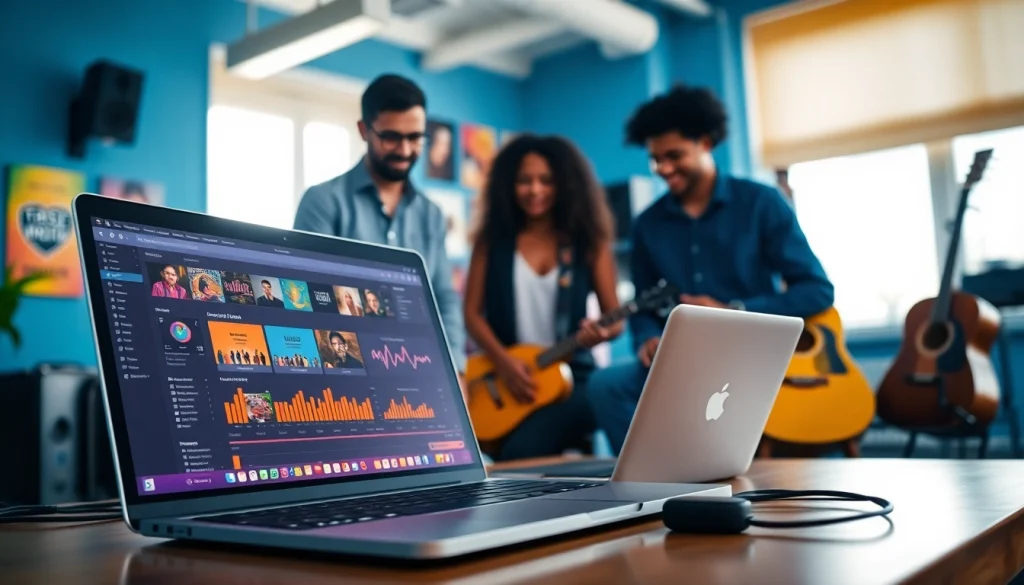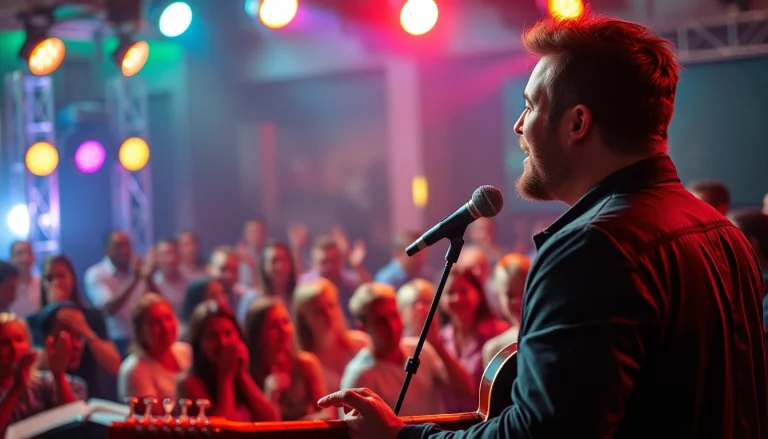
Understanding Music Promotion Services
What Are Music Promotion Services?
Music promotion services encompass a range of strategies and tools that help artists and musicians gain visibility, connect with fans, and increase their streaming numbers or sales. Essentially, these services are designed to raise awareness of an artist’s music by utilizing various platforms, including social media, digital advertising, and playlist placements. They can be particularly beneficial for independent artists or up-and-coming musicians who may not have the resources of major record labels. Many of these services focus on reaching target audiences through curated playlists, engaging social media campaigns, press releases, and strategic partnerships.
Why Music Promotion is Crucial for Artists
In today’s digital landscape, simply releasing music is often not enough to achieve success. Artists must proactively engage in promotional activities to ensure their music reaches a wider audience. Music promotion services are crucial because they help artists cut through the noise of a congested marketplace. The majority of music released goes unheard; thus, effective promotion can be the difference between obscurity and a thriving career. Additionally, music promotion can lead to pivotal opportunities such as gigs, collaborations, and media coverage that are essential for an artist’s growth.
Types of Music Promotion Services Available
Various music promotion services are available to artists, tailored to meet their specific needs. Here are some common types:
- Social Media Promotion: Using platforms such as Instagram, Facebook, and TikTok to engage with fans and promote releases through organic and paid methods.
- Playlist Promotion: Getting music featured on popular playlists across platforms like Spotify, Apple Music, and YouTube, which can significantly boost streams and visibility.
- Public Relations (PR): Crafting press releases, reaching out to media outlets, bloggers, and influencers to generate buzz and get coverage for new releases.
- Advertising Campaigns: Utilizing targeted ads on social media, Google, or music streaming apps to reach potential listeners.
- Live Event Promotion: Promoting concerts, live streaming events, or tours through various channels to maximize attendance and engagement.
- Email Marketing: Building and segmenting a mailing list to keep fans informed about new releases, merchandise, and tour dates.
- Digital Distribution: Services that not only promote music but also distribute it across multiple platforms to reach a broader audience.
Choosing the Right Music Promotion Services
Evaluating Service Providers
When selecting a music promotion service, it is crucial for artists to thoroughly research and evaluate potential providers. This includes considering their track record with previous clients, the types of services they offer, and their overall reputation in the industry. Additionally, artists should seek reviews, testimonials, and case studies to gauge how effective these services have been for other musicians. Engaging with other artists who have utilized these services can provide valuable insights into what to expect.
Key Features to Look For
There are several key features to consider when evaluating music promotion services:
- Target Audience Insights: The ability to define and reach specific demographics that align with the artist’s music style.
- Transparent Reporting: Access to regular updates and analytics that showcase the results of promotional efforts.
- Experience and Credibility: Established networks within the industry, including connections with playlists, blogs, and influencers.
- Tailored Strategies: Customized promotional plans that fit the artist’s unique brand and goals rather than generic packages.
- Support Services: Ongoing support and communication throughout the promotion process, ensuring the artist feels involved and informed.
Cost-Effectiveness of Various Solutions
Cost can vary significantly across music promotion services, influenced by the range of services offered and the provider’s experience. It’s essential for artists to assess the return on investment (ROI) for each option. Cheaper isn’t always better; a service with higher upfront costs might deliver more significant results than a budget service. Artists should weigh the potential exposure and increased streams against the cost of each service, keeping their career goals and budgets in mind. It often pays to invest in a reliable service that aligns with long-term career growth rather than opting for lower-cost, less impactful options.
Strategies for Successful Music Promotion
Social Media Marketing Tactics
Social media is an integral part of music promotion strategies. Artists should optimize their profiles to reflect their brand and engage with fans consistently. Here are effective tactics:
- Content Creation: Regularly produce engaging content, including behind-the-scenes videos, live Q&As, and teasers of upcoming songs or albums.
- Collaborative Campaigns: Partner with other artists or influencers to reach new audiences and create buzz around music releases.
- Utilizing Stories and Reels: Platforms like Instagram offer various formats such as Stories and Reels to creatively showcase music and engage followers.
- Fan Engagement: Respond to comments and direct messages to foster a community and loyalty among fans.
- Use of Hashtags: Implement relevant hashtags to increase visibility and attract new listeners.
Leveraging Playlists and Streaming Services
With the rise of music streaming platforms, getting featured on playlists can dramatically influence an artist’s reach. Strategies include:
- Researching Playlist Curators: Identify and reach out to those who manage playlists that fit the genre and vibe of the artist’s music.
- Creating Personal Playlists: Utilize platforms to create themed playlists that include their own songs among other popular tracks, driving traffic back to their music.
- Submitting Music to Playlists: Use services that specialize in playlist placement for broader outreach.
- Monitoring Trends: Stay updated on emerging playlists and genres to align submissions accordingly.
Building a Strong Artist Brand
Establishing a solid brand is pivotal for artists in a crowded market. Here are steps to cultivate a compelling artist identity:
- Consistent Messaging: Ensure that all promotional materials reflect a cohesive brand message, from album artwork to social media content.
- Unique Visuals: Invest in professional photography and design to stand out visually. Creative visuals make a lasting impression.
- Engaging Storytelling: Share the artist’s journey, influences, and stories that resonate with fans and foster emotional connections.
- Public Image Management: Actively manage public appearances and interactions with the press to maintain a favorable image.
Measuring the Impact of Music Promotion
Key Performance Indicators (KPIs) to Track
Measuring the success of promotion strategies is essential for refining future efforts. Here are key performance indicators to monitor:
- Streaming Numbers: Track the number of streams before and after promotions to gauge effectiveness.
- Social Media Engagement: Measure likes, shares, comments, and overall audience growth on social media platforms.
- Website Traffic: Monitor the amount of traffic directed to the artist’s official website or landing page.
- Playlist Adds: Assess how many playlists feature the artist’s music following outreach efforts.
- Press Mentions: Count the number of media outlets that feature the artist, as increased press can drive awareness and credibility.
Using Analytics Tools for Insights
Leverage analytics tools available on various platforms to gain insights into audience behavior and engagement. For instance:
- Spotify for Artists: Provides detailed analytics about who is listening to music, including demographics and geography.
- Google Analytics: Offers insights into website traffic, user engagement, and conversion rates, thereby assessing the effectiveness of specific campaigns.
- Social Media Insights: Each social platform provides analytics to track engagement metrics and audience growth, informing future strategies.
Adjusting Strategies Based on Data
Data-driven decision-making should guide promotional strategies. Artists should regularly review performance metrics to:
- Tweak Campaigns: Make adjustments to ongoing campaigns based on what’s working well and what isn’t.
- Shift Focus: If certain platforms or promotional tactics yield better results, shift resources and focus there.
- Set New Goals: Use data to set realistic and data-backed goals for future releases or promotional efforts.
- Test and Learn: Implement A/B testing on various strategies to find the most effective approaches.
Case Studies of Successful Music Promotion Campaigns
Independent Artist Success Stories
Many independent artists have harnessed music promotion services to achieve remarkable success. For example, an indie artist may begin with a small social media following but decide to invest in strategic playlist placements and social media ads. After a well-executed campaign, they experience a surge in streams and an increase in followers, leading to sold-out shows and brand partnerships within just a few months.
Lessons from Major Label Campaigns
Major labels have the resources to execute large-scale promotional strategies that smaller artists can learn from. Successful campaigns often include a mix of PR efforts, music videos, and promotional tours. A notable example includes a well-known pop artist who used a combination of high-profile collaborations and streaming exclusives to build momentum for an album release, resulting in record-breaking sales and streaming numbers.
Innovative Approaches in Music Promotion
As the music industry evolves, so do promotional strategies. One innovative approach includes utilizing cryptocurrency for fan engagement and support, allowing artists to fund projects directly through their communities. Integration of augmented reality (AR) for music videos that allow immersive fan experiences is another novel tactic that connects audience engagement with promotional activities.






